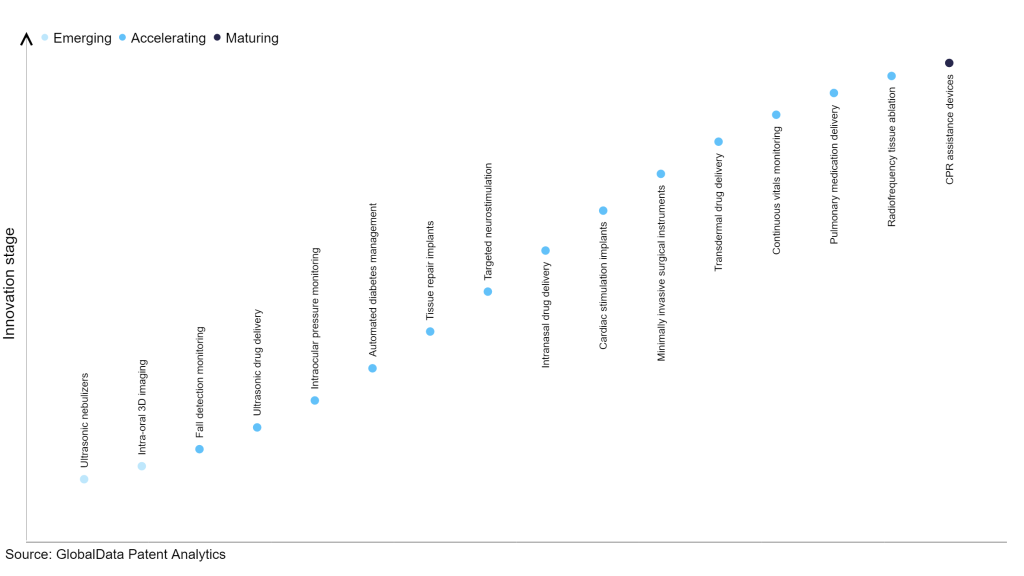The medical devices industry continues to be a hotbed of patent innovation. Activity is driven by increased need for homecare, preventative treatments, early diagnosis, reducing patient recovery times and improving outcomes, and growing importance of technologies such as machine learning, augmented reality, 5G and digitalization. In the last three years alone, there have been over 710,000 patents filed and granted in the medical devices industry, according to GlobalData’s report on Innovation in medical: CPR assistance devices. Buy the report here.
However, not all innovations are equal and nor do they follow a constant upward trend. Instead, their evolution takes the form of an S-shaped curve that reflects their typical lifecycle from early emergence to accelerating adoption, before finally stabilizing and reaching maturity.
Identifying where a particular innovation is on this journey, especially those that are in the emerging and accelerating stages, is essential for understanding their current level of adoption and the likely future trajectory and impact they will have.
30+ innovations will shape the medical devices industry
According to GlobalData’s Technology Foresights, which plots the S-curve for the medical devices industry using innovation intensity models built on over 155,000 patents, there are 30+ innovation areas that will shape the future of the industry.
Within the emerging innovation stage, ultrasonic nebulizers and intra-oral 3D imaging are disruptive technologies that are in the early stages of application and should be tracked closely. Intraocular pressure monitoring, automated diabetes management, and tissue repair implants are some of the accelerating innovation areas, where adoption has been steadily increasing. Among maturing innovation areas is CPR assistance devices, which is now well established in the industry.
Innovation S-curve for the medical devices industry

CPR assistance devices is a key innovation area in medical devices
CPR assistance devices are electronic devices and systems designed to assist medical professionals and lay rescuers in performing cardiopulmonary resuscitation (CPR) on a patient effectively. These devices provide real-time guidance, feedback, or automated compression and ventilation support to ensure that chest compressions and rescue breaths are administered correctly during emergency situations, ultimately increasing the chances of saving a life in cases of cardiac arrest or other life-threatening conditions.
GlobalData’s analysis also uncovers the companies at the forefront of each innovation area and assesses the potential reach and impact of their patenting activity across different applications and geographies. According to GlobalData, there are 10+ companies, spanning technology vendors, established medical devices companies, and up-and-coming start-ups engaged in the development and application of CPR assistance devices.
Key players in CPR assistance devices – a disruptive innovation in the medical devices industry
‘Application diversity’ measures the number of applications identified for each patent. It broadly splits companies into either ‘niche’ or ‘diversified’ innovators.
‘Geographic reach’ refers to the number of countries each patent is registered in. It reflects the breadth of geographic application intended, ranging from ‘global’ to ‘local’.
Patent volumes related to CPR assistance devices
| Company | Total patents (2021 - 2023) | Premium intelligence on the world's largest companies |
| Asahi Kasei | 108 | Unlock Company Profile |
| Koninklijke Philips | 60 | Unlock Company Profile |
| Stryker | 47 | Unlock Company Profile |
| Radial Medical | 18 | Unlock Company Profile |
| Shenzhen Mindray Bio-Medical Electronics | 8 | Unlock Company Profile |
| Credo Reference | 8 | Unlock Company Profile |
| Atreo Medical | 6 | Unlock Company Profile |
| Nihon Kohden | 5 | Unlock Company Profile |
| Mediana | 4 | Unlock Company Profile |
| Xhale | 4 | Unlock Company Profile |
| Lifewave Biomedical | 3 | Unlock Company Profile |
| LifeWave | 2 | Unlock Company Profile |
| CPR Therapeutics | 2 | Unlock Company Profile |
| Nippon Koden Kogyo | 1 | Unlock Company Profile |
Source: GlobalData Patent Analytics
Asahi Kasei is one of the leading patent filers in the field of CPR assistance devices. Some other key patent filers in the field include Koninklijke Philips, Stryker, and Radial Medical.
In terms of application diversity, Mediana leads the pack, while Atreo Medical, and Lifewave Biomedical stood in the second and third positions, respectively. By means of geographic reach, Radial Medical held the top position, followed by Koninklijke Philips and Asahi Kasei.
Providing real-time guidance and feedback during resuscitation efforts, CPR assistance devices are invaluable for cardiac emergencies, training, and helping individuals gain proficiency in CPR techniques. With the integration of advanced sensors, real-time feedback mechanisms, and compact and portable designs, these devices are poised for remarkable advancements aimed at optimizing the CPR process. These developments are anticipated to centre on enhancing the quality of chest compressions, ease of use, accessibility, and overall performance of these critical life-saving devices.
To further understand the key themes and technologies disrupting the medical devices industry, access GlobalData’s latest thematic research report on Medical Devices.
Data Insights
From

The gold standard of business intelligence.
Blending expert knowledge with cutting-edge technology, GlobalData’s unrivalled proprietary data will enable you to decode what’s happening in your market. You can make better informed decisions and gain a future-proof advantage over your competitors.







